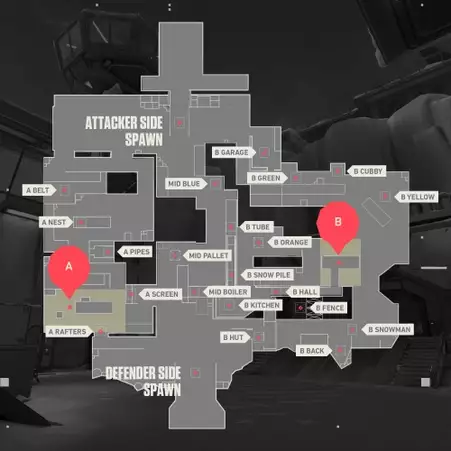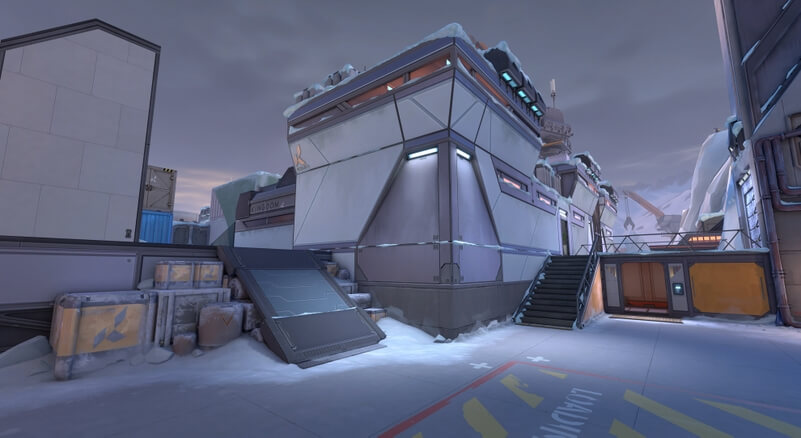Unlock the secrets of Valorant’s Icebox map! Enhance your gameplay with this deep dive into its strategic complexity, vertical challenges, and tactical playstyles.
As an astute player on the quest for mastery within Valorant’s competitive realm, your strategic approach to the game can be significantly enhanced by a comprehensive understanding of the Icebox map. Introduced to the Valorant universe, Icebox presents a challenging terrain of close quarters and long sightlines that demands precise coordination and sharp shooting skills. With its unique verticality and intricate design, this map requires you to adapt and refine your tactics continually, ensuring that every match is as unpredictable as it is exhilarating. The key to conquering Icebox lies in leveraging its complex environment to outmaneuver opponents, making it an essential study for anyone serious about elevating their Valorant gameplay.
Overview of Icebox
Setting and Theme
You’ll find Icebox set in an abandoned Kingdom excavation site that’s been overtaken by the frigid arctic climate. The theme revolves around a blend of industrial complex features laced with shipping containers, crane structures, and snow-covered terrain. As you navigate this map, the wintry atmosphere is palpable, contributing to the immersive experience of strategic combat.

Icebox minimap – copyright Riot Games
Map Structure and Layout
Icebox presents you with a multi-level battlefield, emphasizing both horizontal and vertical gameplay. The map consists of two bomb sites, labeled A and B, with varied elevations and structures. Routes stemming from Attacker and Defender spawns lead to complex areas with numerous opportunities for engagements, requiring critical strategic thinking.
Unique Features of Icebox
Distinctive to Icebox are its vertical ziplines and areas that allow combat above ground level, which introduce a new dimension to your approach in gunfights and map navigation. This map also entails destructible objects that shape sightlines and pathways, providing another layer of tactical depth to your gameplay.
Comparisons to Other Valorant Maps
Unlike other maps in Valorant, Icebox significantly deviates by incorporating pronounced verticality and tight corridors, standing in contrast to the usually expansive and flatter battlegrounds. Its intricate design often results in more close-quarter confrontations and can transform the tempo of play uncharacteristically for Valorant maps.
History and Development
Icebox Release Date
Icebox graced your gaming sessions as an addition to the Valorant map pool on October 13, 2020. Its introduction was part of Episode 1, Act III of the game’s release cycle, expanding the strategic landscapes you could venture into.
Updates and Changes Over Time
Since Icebox’s unveiling, there have been various updates to refine the gameplay experience. Adjustments to angles, sightlines, and object placement have been made, improving playability and competitive balance based on in-depth analysis and community feedback.
Community Reception and Feedback
Upon release, community reception was mixed, with players challenged by the unique layout and environmental conditions. However, over time and through subsequent refinements, many in the community have grown to appreciate the complexity and the distinct playstyle that Icebox encourages.
Icebox in Valorant’s Competitive Play
In competitive play, Icebox was initially met with hesitation due to unfamiliarity. As teams developed specialized strategies, the map gained acceptance for its depth and the dynamic engagements it produces, solidifying its position in tournament rotations.
Key Areas of the Map
Defender’s Spawn
Your initiative as a Defender on Icebox is centrally placed between both sites, allowing for swift rotation. The spawn area connects to several defensive positions offering you strong control over map access points.
Attacker’s Spawn
As an Attacker, you initiate from an area with direct routes to A and B sites, along with additional paths toward the middle of the map. This gives you multiple approaches to consider and execute your team’s plan of attack.
The A Site
The A Site on Icebox is a multi-level area featuring the iconic A Belt and A Rafters, which present a wealth of vertical play and angle holding options. This site demands a coordinated attack and defense due to its complexity and abundance of hiding spots.
The B Site
Your challenges on the B Site revolve around its open space juxtaposed with obstructing containers and an overlook from B Yellow. The site’s layout imposes an emphasis on utility usage and post-plant positioning to secure round victories.
Mid Control and Importance
Uniquely, the middle section of Icebox, known as Mid, plays a pivotal role in map control. Dominating this area allows for rotation manipulation and unpredictable attack vectors, a vital component in your strategic arsenal.
Special Mechanics
Vertical Ziplines
The inclusion of vertical ziplines in Icebox affords you a rapid change in altitude, granting access to positions that oversee critical areas. Mastery of zipline movement can be the key to outmaneuvering opponents.
Destructible Objects
Manipulating the battleground is possible with destructible objects. By breaking these, you can create new sightlines or eliminate enemy cover, adjusting the dynamic of engagements on the fly.
Unique Angles and Sightlines
Icebox’s design fosters unique angles and sightlines, urging you to constantly refine your crosshair placement and spatial awareness. These distinctive vantage points can lend you the upper hand in anticipation of enemy movement.
Environmental Hazards
Its icy terrain and chilling winds don’t just serve a visual purpose. These environmental hazards subtly impact your auditory cues and visual clarity, adding another dimension to combat you must stay cognizant of.
Strategic Gameplay
Site Executions and Defenses
Executing on and defending bomb sites in Icebox involves layered strategies that encompass efficient use of abilities, sightline control, and vertical aggression. You’re tasked with orchestrating multi-faceted tactics to secure areas for planting or retake.
Agent Synergies
Choosing agents with synergistic abilities elevates your team’s efficiency on Icebox. Combinations like using Viper’s toxic screen with Sage’s barrier orb tailor to the map’s diversity, blending area denial with solid fortifications.
Common Strategies and Tactics
On Icebox, strategies often involve aggressive control over angles with a mix of bait-and-switch tactics, elevation utilization, and sudden pinch attacks through Mid. A common defense stratagem is the layered defense, spacing agents to waste the attackers’ time and utility.
Economic Aspects on Icebox
Your economic management on Icebox can be more demanding due to the frequency of close-quarter combat. The map sometimes necessitates an additional emphasis on force buys and shotgun efficacy, given the tighter engagement spaces.
Map-Specific Challenges
Difficulty in Attacking and Defending
Icebox challenges both attackers and defenders with its labyrinthine structure, requiring you to execute well-coordinated maneuvers and capitalize on minute positional advantages.
Tight Chokepoints and Flanking Routes
Navigating through Icebox’s chokepoints can be perilous; a well-placed utility from the enemy can thwart your passage. Conversely, the map’s flanking routes entice you to surprise and ensnare unsuspecting foes.
Visibility Issues
Due to the contrasting outdoor brightness and dark interiors, you may encounter visibility issues that hinder identification of opponents. Adapting to Icebox’s visual environment is indispensable for your success.
Adaptation to Weather Conditions
While the weather on Icebox is primarily aesthetic, the snow and cold atmosphere add an underlying tone to your gameplay. Adjusting to these conditions mentally can be part of the holistic challenge the map poses.
Agent Picks and Team Composition
Popular Agents on Icebox
Agents like Viper, Sage, and Omen enjoy popularity on Icebox due to their abilities to control space and provide tactical advantages in a map rife with vertical play and tight corners.
Role Specialization
Icebox encourages role specialization, where controllers, initiators, and sentinels can excel when applying their distinctive strengths. Your choice of agents can facilitate successful plays or turn the tide when stalling or retaking a site.
Impact of Agent Abilities
Your adeptness with agent abilities can be pivotal in securing round wins. Whether it’s leveraging Sage’s wall for unexpected elevation or using Raze’s explosive ordnance to clear tight spaces, mastering these impacts will enhance your gameplay.
Counterpicking Strategies
Developing counterpicking strategies becomes crucial on Icebox, where anticipating the opposing team’s composition and responding with strategic agent choices can dismantle their planned executions.
Role of Utility Usage
Smokes and Vision Blocks
Effective deployment of smokes and vision-blocking abilities can compartmentalize engagements and redefine control zones. On Icebox, you will find that such precision in utility usage is key to creating safe passages and denying enemy lines of sight.
Movability and Map Control
Agents with enhanced movability like Jett or Raze can leverage the map’s verticality and provide swift map control. Your use of these movements can outpace opponents’ rotations and unlock unconventional attack angles.
Information Gathering
Gathering intel on opposing positions with Sova’s recon tools or Cypher’s spy cam can pivot your decisions between pressing forward or falling back, providing you with a considerable strategic advantage.
Timing and Precision of Utility
The constrained spaces and tight angles of Icebox necessitate the precise timing and placement of utility. Your ability to synchronize abilities with your teammates’ plays can seal a site’s fate.
The Impact of Patch Changes
Changes in Agent Meta
Patch updates invariably shape the meta, particularly on a map like Icebox. The ebb and flow of agents’ popularity in the roster are often connected to your and others’ experiences with these alterations.
Map Layout Alterations
Timestamped changes to Icebox’s layout, such as opening or sealing pathways, adjustments to cover, and platform placement, force a revision of your strategies and compel continual learning.
Balancing Issues
Balancing tweaks concerning Icebox must be carefully dissected as they can shift the overall fairness for attackers or defenders. Your adaptability is tested each time these refinements are implemented.
Community’s Adaptation to Changes
Your shared adaptation to Icebox changes, along with the community, contributes to evolving tactics and playstyles. Embracing these shifts is part of the ceaseless pursuit of competitive proficiency.
Community and Esports
Tournaments Featuring Icebox
Icebox has found its place within the tournament scene, frequently being vetted in competitive rotations. Strong showings on this map by high-level players provide rich insights into its deepest strategic potential.
Fan-Favorite Features and Areas
Certain segments of Icebox, such as the intense battleground of A Site and the deceptively simple yet strategic Mid lane, have become favorites for many fans who relish the chess-like gameplay it encourages.
Streamer and Content Creator Perspectives
Content creators and streamers showcase a myriad of approaches to Icebox, each providing a new perspective that can inform and inspire your own gameplay. Their diverse playstyles and commentary offer practical and tactical knowledge.
Esports Teams Dominance on the Map
Observing esports teams that excel on Icebox can be enlightening; their dominance often derives from well-honed teamwork and a nuanced understanding of the map. Analyzing their gameplay reveals innovative uses of agents and pioneering strategies.
